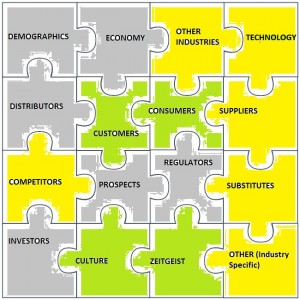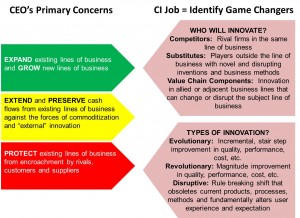Competitive Intelligence practitioners understand the need to analyze and draw insights from the competitive landscape. And, as most practitioners know, this landscape is broader than simply looking at direct rivals. In public lectures, my friend Seena Sharp likens the landscape to a puzzle, one that differs by company and industry.
Strategic thinkers among us talk much about analyzing this puzzle. But we often forget how hard it is to populate the puzzle in the first place. The challenge is to understand where change is happening now and likely to happen in the future. These centers or drivers of change form the crucial puzzle pieces CI teams have to consider.
However, many of us may be unsuited to the task. Most of us understand demographics and economics; we’re pretty good at competitive psychology; and we might fancy ourselves students of culture. But what about technology? More importantly, what about the intersection of technology with other trends and change drivers? How well are we able to see the interaction of technology with problems and unmet needs that is going on just below the surface of perception, and that sparks that most important change driver of all, innovation?
Integrating technical intelligence into the competitive intelligence mission enables us to get at these questions and expose the possible sources and direction of innovation in our industries.
Now in part one of this series, I challenged the notion that C-Suite executives are insufficiently future focused. The reason executives appear preoccupied with the short term, is they understand that without short term success, long term dreams never come true. The fact is they are paid to be worry about the near, medium AND long term … and to try to understand the relationship between each.
Competitive Intelligence has to help the C-Suite with both challenges: Win in the short term so that the firm can discover and execute long term growth options. Technology and innovation represents perhaps the most powerful threat to a firm’s near and long term success. Understanding technology and innovation is also a tremendous pathway to finding ways for the firm to lead innovation, win in the market, and deliver the company’s long range goals. Here’s the challenge visually:
Technical Intelligence brings tools to the party to help find where innovation is coming from and what it will do to the landscape. It can also help sort out what moves the company should make to seize the lead in innovation. On October 10th at RECONVERGE:G2 in Indianapolis, some of the best Technical Intelligence practitioners in the business share how they have helped organizations look into the near and long term future to figure who will innovate and how.
Originally posted at RECONVERGE.NET on September 20, 2013.


